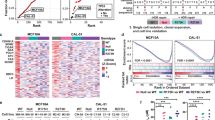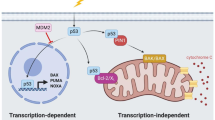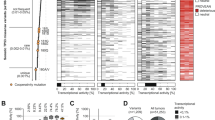Abstract
Tumor-derived p53 mutants can transcriptionally activate a number of promoters of genes involved in cellular proliferation. For this transactivation, mutant p53 does not use the wild-type p53 DNA-binding site, suggesting a mechanism of transactivation that is independent of direct DNA binding. Here we describe our analysis of the domain requirements for mutant p53 to transactivate promoters of the human epidermal growth factor receptor (EGFR), human multiple drug resistance 1 (MDR-1) and human proliferating cell nuclear antigen (PCNA) genes. We also report the identification of a structural domain required for the `gain of function' property of mutant p53-281G. `Gain of function' is measured as the tumorigenicity (in nude mice) of 10(3) murine cells expressing mutant p53 constitutively. We have generated internal deletion mutants of p53-281G deleting conserved domains I, II, III, IV and V, individually. We have also generated one deletion mutant eliminating amino acids 100 through 300 that removes four of the five conserved domains (II–V); another mutant, p53-281G del 393-327, deletes the oligomerization and nonsequence-specific nucleic acid-binding domains of p53. For the EGFR and MDR-1 promoters, all these mutants have significantly lower transactivation ability than intact p53-281G. These deletion mutants, however, significantly activated the pCNA promoter, suggesting that the mechanism of transactivation of the PCNA promoter is different from that of the EGFR and MDR-1 promoters. When expressed constitutively in 10(3) cells, p53-281G del 393-327 was found to be defective in inducing tumor formation in nude mice although intact p53-281G was very efficient. Thus, our results suggest that structural domains near the C-terminus are needed for `gain of function'.
This is a preview of subscription content, access via your institution
Access options
Subscribe to this journal
Receive 50 print issues and online access
$259.00 per year
only $5.18 per issue
Buy this article
- Purchase on Springer Link
- Instant access to full article PDF
Prices may be subject to local taxes which are calculated during checkout
Similar content being viewed by others
Author information
Authors and Affiliations
Rights and permissions
About this article
Cite this article
Lányi, Á., Deb, D., Seymour, R. et al. `Gain of function' phenotype of tumor-derived mutant p53 requires the oligomerization/nonsequence-specific nucleic acid-binding domain. Oncogene 16, 3169–3176 (1998). https://doi.org/10.1038/sj.onc.1201857
Received:
Revised:
Accepted:
Published:
Issue Date:
DOI: https://doi.org/10.1038/sj.onc.1201857
Keywords
This article is cited by
-
The oncogenicity of tumor-derived mutant p53 is enhanced by the recruitment of PLK3
Nature Communications (2021)
-
p53 mutations in cancer
Nature Cell Biology (2013)
-
Current understanding of the role and targeting of tumor suppressor p53 in glioblastoma multiforme
Tumor Biology (2013)
-
Resistance of mitochondrial p53 to dominant inhibition
Molecular Cancer (2008)
-
Transcription regulation by mutant p53
Oncogene (2007)



